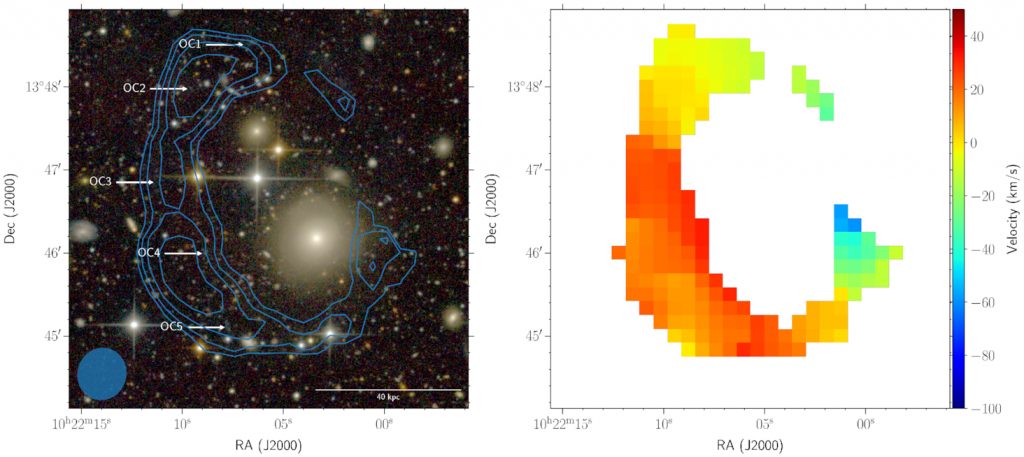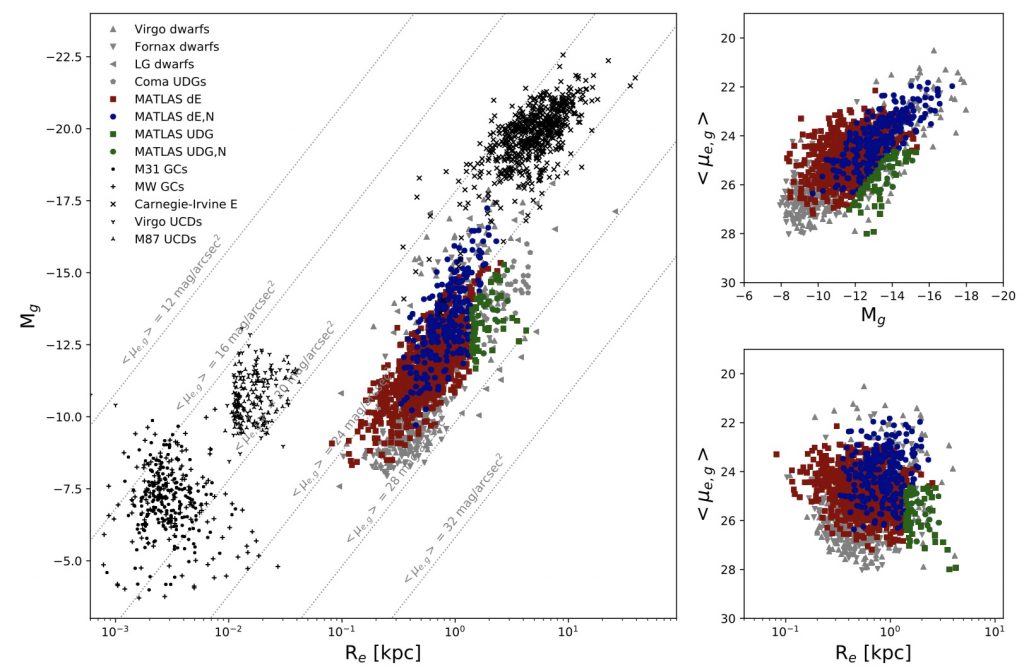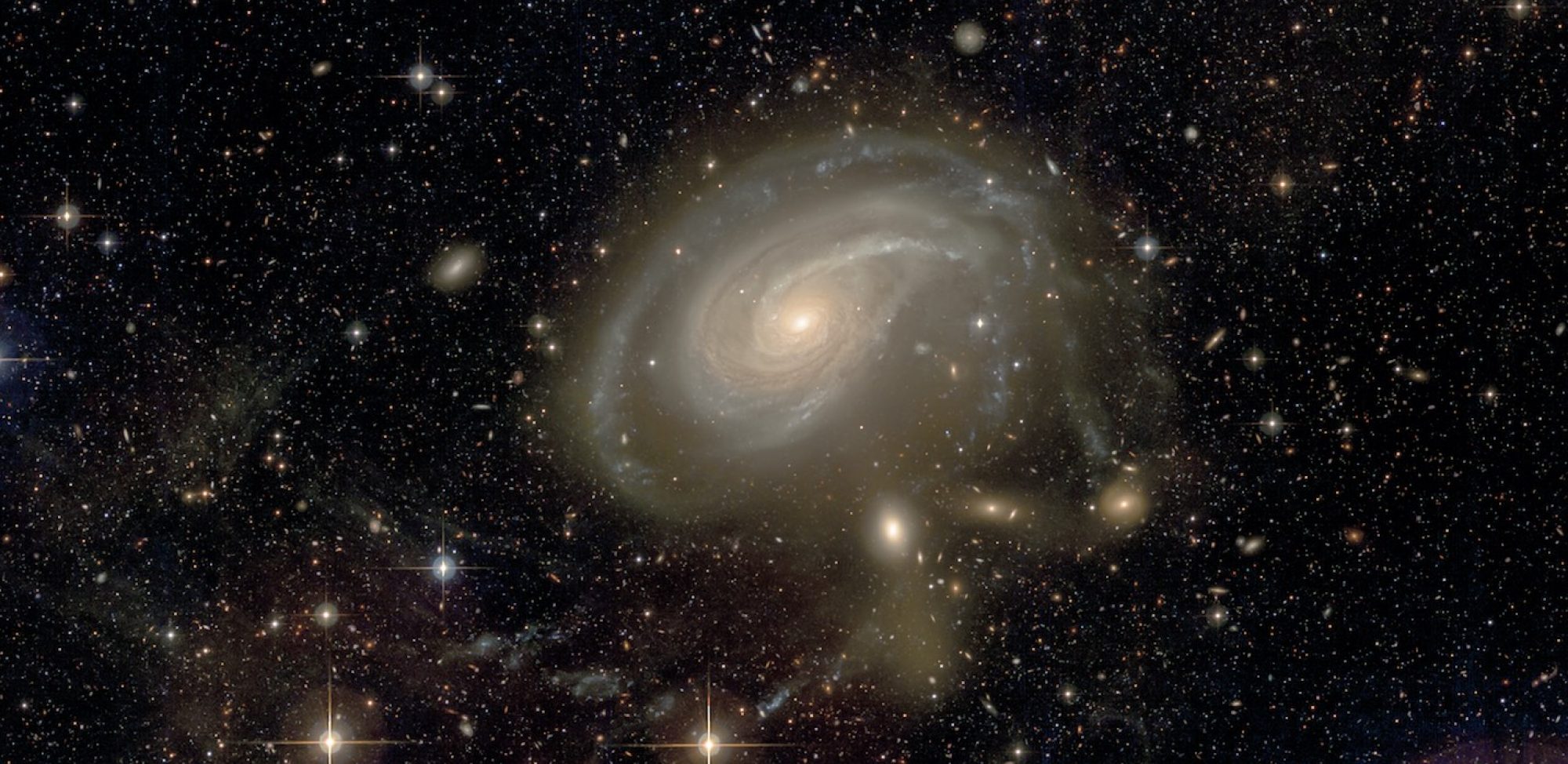Cold gas and dust: Hunting spiral-like structures in early type galaxies

Observations of neutral hydrogen (HI) and molecular gas show that 50% of all nearby early-type galaxies (ETGs) contain some cold gas. Molecular gas is always found in small gas discs in the central region of the galaxy, while neutral hydrogen is often distributed in a low-column density disc or ring typically extending well beyond the stellar body. Dust is frequently found in ETGs as well. The goal of our study is to understand the link between dust and cold gas in nearby ETGs as a function of HI content.
Discovery of a large H I ring around the quiescent galaxy AGC 203001 (associated paper)

Here we report the discovery with the Giant Metrewave Radio Telescope of an extremely large (̃115 kpc in diameter) H I ring, located around a massive quenched galaxy, AGC 203001, but off-centered, with respect to it. This ring does not have any bright extended optical counterpart unlike several other known ring galaxies. Our deep g, r, and i optical imaging of the H I ring, using the MegaCam instrument on the Canada-France-Hawaii Telescope, shows however several regions with faint optical emission at a surface brightness level of ̃28 mag/arcsec2.
Continue reading “Discovery of a large H I ring around the quiescent galaxy AGC 203001 (associated paper)”Probing the merger history of red early-type galaxies with their faint stellar substructures

Several detailed observations, such as those carried out at the Canada-France-Hawaii Telescope (CFHT), have revealed prominent Low Surface Brightness (LSB) fine structures that lead to a change in the apparent morphology of galaxies. Previous photometry surveys have developed observational techniques which make use of the diffuse light detected in the external regions of galaxies. In these studies, the outer perturbations have been identified and classified. These include tidal tails, stellar streams, and shells. These structures serve as tracers for interacting events and merging events and retain some memory of the mass assembly of galaxies. Cosmological numerical simulations are required to estimate their visibility timescale, among other properties, in order to reconstruct the merger history of galaxies. In the present work, we analyze a hydrodynamical cosmological simulation to build up a comprehensive interpretation of the properties of fine structures.
Continue reading “Probing the merger history of red early-type galaxies with their faint stellar substructures”MATLAS: a deep exploration of the surroundings of massive early-type galaxies

The MATLAS project explores the surroundings of a complete sample of nearby massive early-type galaxies with multi-colour deep optical images obtained at the Canada- France Hawaii Telescope. The observing and data reduction techniques ensured the detection of extended low-surface-brightness (LSB) structures, while the high image quality allowed us to identify associated compact objects such as star clusters. A number of scientific topics are addressed with this data-set that are briefly presented in this review: the study of foreground Galactic cirrus at high spatial resolution, telling us about the ISM structure; the characterisation of collisional debris around the galaxies (streams, tails, shells, stellar halos), giving hints on their past merger history; the distribution of dwarf galaxy satellites, including the ultra-diffuse ones, together with their globular cluster population, which are additional tracers of the formation and mass assembly of galaxies.
Published in IAU S355, The real of low surface brightness universe, La Laguna, 2019
MATLAS Dwarfs I: Hunting for Dwarf Galaxies and Ultra Diffuse Galaxies in Low Density Environments

The properties of low surface brightness dwarf galaxies found in low-density environments are poorly constrained observationally. This problem is two-fold, as many studies (1) focus on dwarfs in the Local Group or cluster environments, or (2) lack either the depth or coverage to detect a large sample of dwarf galaxies. These issues can be overcome using the Mass Assembly of early Type gaLAxies with their fine Structures (MATLAS) large observing program, which has imaged ∼142 deg2 of the sky around nearby [primarily] isolated early type galaxies (ETGs) down to surface brightnesses of ∼ 28.5 in the g-band using MegaCam on the Canada France Hawaii Telescope. This is the first of a series of papers in which we intend to fully characterize the properties of the 2210 dwarf candidates we have identified in the MATLAS imaging.
Continue reading “MATLAS Dwarfs I: Hunting for Dwarf Galaxies and Ultra Diffuse Galaxies in Low Density Environments”Protected: Newsletter: 04/09/2019
The molecular gas content of shell galaxies (associated paper)

Shells are fine stellar structures identified by their arc-like shapes present around a galaxy and currently thought to be vestiges of galaxy interactions and/or mergers. The study of their number, geometry, stellar populations and gas content can help to derive the interaction/merger history of a galaxy. Numerical simulations have proposed a mechanism of shell formation through phase wrapping during a radial minor merger. Alternatively, there could be barely a space wrapping, when particles have not made any radial oscillation yet, but are bound by their radial expansion, or produce an edge-brightened feature. These can be distinguished, because they are expected to keep a high radial velocity. While shells are first a stellar phenomenon, HI and CO observations have revealed neutral gas associated with shells. Some of the gas, the most diffuse and dissipative, is expected to be driven quickly to the center if it is travelling on nearly radial orbits. Molecular gas, distributed in dense clumps, is less dissipative, and may be associated to shells, and determine their velocity, too difficult to obtain from stars.
Continue reading “The molecular gas content of shell galaxies (associated paper)”Protected: Annotation de galaxies
Shells around NGC 474 (image release)

A network of shells of various colors and thus stellar populations around the ETG NGC0474. True color (combination of g and r bands) image obtained with the MegaCam camera at CFHT as part of the Atlas3D project, and processed by Coleum. Appeared in the 2012 issue of the CFHT calendar and in the Astronomical Picture of the Day
This system is discussed in Lim et al. (2017), who present evidence for the association of globular clusters with the shells.

